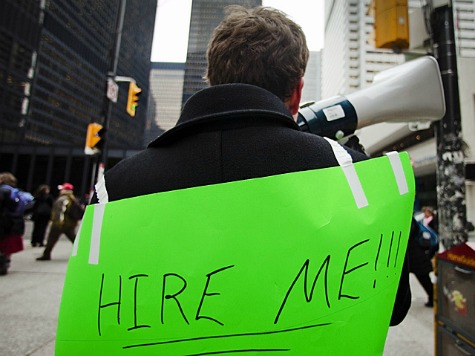The economy created only 74,000 jobs in December, well below the 2013 average of 188,000. The Labor Department report indicates stronger growth for the coming year predicted by many economists may not materialize.
Growth slipped to 1.9 percent last year, thanks to the $200 billion January tax increase and sequestration spending cuts; this is simply not enough to bring unemployment down to an acceptable level, support strong wage gains, and reduce income inequality.
This report indicates that neither the economy nor the job market have shifted into high gear as the White House preaches and private economists who flack for the Administration have claimed.
Unemployment dropped to 6.7 percent because 525,000 additional unemployed adults were discouraged and did not seek a job. Also, many prime working-age adults remain stuck in low-wage, part-time jobs with few or no benefits.
Factoring in those frustrated adults, the jobless rate rises to 13.1 percent. The economy needs to add about 365,000 jobs each month to push unemployment down to about 6 percent and provide those folks with decent paying, full-time employment. That would require GDP growth in the range of 4 to 5 percent.
Over the last four years, the pace has been a paltry 2.3 percent, but much stronger growth is possible. During the Reagan recession of the early 1980s, unemployment peaked at a much higher level than during the recession Obama inherited, and GDP advanced at 4.9 percent over the comparable period of recovery.
Slow growth and weak demand for labor are among the primary causes of wage stagnation, inequality, and worsening conditions for families at the lower end of the income ladder. Retailers catering to those families, such as Family Dollar Stores, Sears, and K-Mart, had weak holiday sales. In the year ahead, price cuts and even thinner margins will be necessary to sustain their sales as the outlook for their customers remains poor.
The defining difference between the recent recovery and the strong record of the 1980s has been the Obama Administration’s reliance on policies that simply address the symptoms of economic stagnation, such as the expansion of Medicare, longer unemployment benefits, and support for a higher minimum wage.
Washington has failed to confront structural issues that cause subpar growth, chronic unemployment, income inequality, and poverty. Important among those are inefficient and dysfunctional government regulation of business; prohibitions on domestic petroleum development off the Atlantic, Pacific, and Eastern Gulf Coasts; and protectionist policies in China and elsewhere in Asia that limit market opportunities for competitive U.S. products.
U.S. automakers are essentially blocked from selling American-made vehicles in China’s huge market, even though Chinese manufacturers are terribly uncompetitive. U.S. carmakers are compelled to form joint ventures and share know-how with Chinese partners to produce and sell in the world’s second largest economy. These and similar restrictions steal millions of American jobs in the auto and supporting industries like electronics, metals and plastics, and computer software.
Eliminating the resulting $450 billion trade deficit on oil and manufactured products would create more than 4 million new jobs directly, and at least another 2.5 million as those additional workers’ spending spread through the economy. This would raise living standards and reduce income inequality much more pervasively than expanding Medicare, raising the minimum wage, and other politically popular but largely ineffective policies.
Peter Morici is an economist and professor at the Smith School of Business,, University of Maryland, and widely published columnist. Follow him on Twitter.

COMMENTS
Please let us know if you're having issues with commenting.